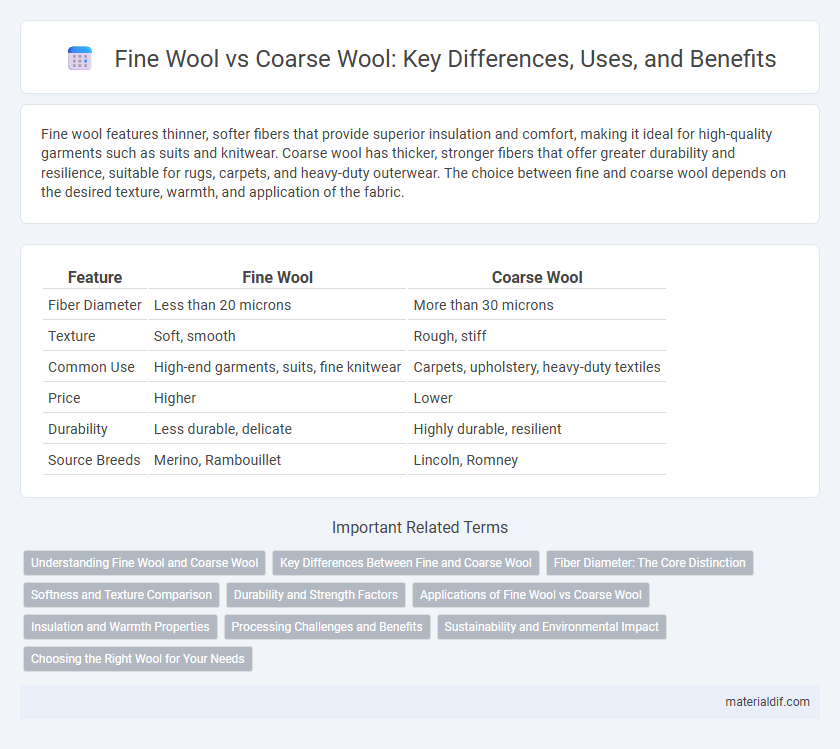Fine wool features thinner, softer fibers that provide superior insulation and comfort, making it ideal for high-quality garments such as suits and knitwear. Coarse wool has thicker, stronger fibers that offer greater durability and resilience, suitable for rugs, carpets, and heavy-duty outerwear. The choice between fine and coarse wool depends on the desired texture, warmth, and application of the fabric.
Table of Comparison
| Feature | Fine Wool | Coarse Wool |
|---|---|---|
| Fiber Diameter | Less than 20 microns | More than 30 microns |
| Texture | Soft, smooth | Rough, stiff |
| Common Use | High-end garments, suits, fine knitwear | Carpets, upholstery, heavy-duty textiles |
| Price | Higher | Lower |
| Durability | Less durable, delicate | Highly durable, resilient |
| Source Breeds | Merino, Rambouillet | Lincoln, Romney |
Understanding Fine Wool and Coarse Wool
Fine wool, characterized by fiber diameters typically below 18 microns, offers exceptional softness, elasticity, and insulation, making it ideal for high-quality garments and luxury textiles. Coarse wool, with fiber diameters exceeding 30 microns, provides greater durability and water resistance, commonly used in carpets, mattresses, and heavy-duty upholstery. Understanding the micron count, crimp, and tensile strength differentiates fine wool's superior comfort from coarse wool's robust functionality in various applications.
Key Differences Between Fine and Coarse Wool
Fine wool, characterized by its soft, thin fibers typically measuring less than 20 microns in diameter, offers superior comfort and is highly sought after for luxury garments and high-quality textiles. Coarse wool, with thicker fibers generally over 30 microns, is more durable and suited for products requiring greater strength and insulation, such as carpets and outerwear. The primary distinctions lie in fiber diameter, softness, durability, and end-use applications, influencing their market value and processing techniques.
Fiber Diameter: The Core Distinction
Fiber diameter is the core distinction between fine wool and coarse wool, with fine wool typically measuring less than 18 microns in diameter and offering superior softness and comfort. Coarse wool, measuring over 30 microns, is more durable and commonly used in carpets and heavy textiles. This difference in fiber diameter directly affects the wool's application, feel, and market value.
Softness and Texture Comparison
Fine wool, primarily sourced from Merino sheep, possesses superior softness and a smooth, delicate texture ideal for next-to-skin garments. Coarse wool, typically from breeds like Romney or Lincoln, has a rougher, thicker fiber structure better suited for durable outerwear and upholstery. The finer crimp and smaller fiber diameter in fine wool enhance softness, while the larger diameter and stronger fiber of coarse wool contribute to its robust texture.
Durability and Strength Factors
Fine wool fibers, typically measuring less than 19 microns in diameter, offer superior softness but tend to be less durable due to their delicate structure. Coarse wool, with fiber diameters exceeding 30 microns, provides enhanced strength and increased resistance to abrasion, making it ideal for heavy-duty textiles. The cell structure of coarse wool contributes to greater tensile strength and longevity, whereas fine wool is more prone to breakage under stress.
Applications of Fine Wool vs Coarse Wool
Fine wool, characterized by its soft texture and high fiber density, is primarily used in luxury garments, high-quality suits, and next-to-skin knitwear due to its comfort and breathability. Coarse wool, with thicker fibers and greater durability, is ideal for carpets, upholstery, and outerwear where resilience and strength are critical. The distinct fiber diameter between fine and coarse wool dictates their suitability for specific textile applications, influencing product quality and performance.
Insulation and Warmth Properties
Fine wool fibers, characterized by diameters typically under 18 microns, provide superior insulation and warmth due to their tighter crimp structure, which traps more air and retains body heat efficiently. In contrast, coarse wool, with fiber diameters often exceeding 30 microns, offers less effective insulation as its larger fibers create larger gaps that reduce heat retention. The softness of fine wool also enhances comfort when worn close to the skin, making it ideal for thermal clothing and cold-weather gear.
Processing Challenges and Benefits
Fine wool, characterized by its thin fiber diameter, poses processing challenges such as increased susceptibility to felting and requires more delicate handling during combing and spinning to maintain fiber integrity. Coarse wool, with thicker fibers, offers benefits like greater durability and easier processing, making it ideal for robust textiles, though it can result in less softness and lower insulation quality. Efficient sorting and grading of wool fiber types enhance the overall quality and performance of the final products.
Sustainability and Environmental Impact
Fine wool, sourced primarily from Merino sheep, offers superior softness and insulation while promoting sustainable farming through lower resource use and enhanced land management practices. Coarse wool, typically from hardy breeds like Romney or Scottish Blackface, requires more intensive land and water resources, leading to a higher carbon footprint and soil degradation risks. Sustainable wool production emphasizes regenerative grazing techniques, reducing methane emissions and preserving biodiversity, making fine wool a more eco-friendly choice in textile manufacturing.
Choosing the Right Wool for Your Needs
Fine wool, such as Merino, offers exceptional softness and breathability, making it ideal for next-to-skin garments like base layers and luxury apparel. Coarse wool, often sourced from breeds like Lincoln or Romney, provides greater durability and insulation, suitable for outerwear, rugs, and heavy-duty textiles. Selecting the right wool depends on the balance between comfort and functionality required for your specific project or garment.
Fine wool vs Coarse wool Infographic

 materialdif.com
materialdif.com